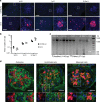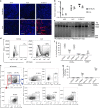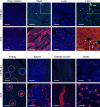Standard screening methods underreport AAV-mediated transduction and gene editing
- PMID: 31363095
- PMCID: PMC6667494
- DOI: 10.1038/s41467-019-11321-7
Standard screening methods underreport AAV-mediated transduction and gene editing
Abstract
Conventional methods to discern adeno-associated virus (AAV) vector transduction patterns are based on high, stable expression of a reporter gene. As a consequence, conventionally described tropisms omit cell types that undergo transient transduction, or have low but undetectable levels of reporter expression. This creates a blind spot for AAV-based genome editing applications because only minimal transgene expression is required for activity. Here, we use editing-reporter mice to fill this void. Our approach sensitively captures both high and low transgene expression from AAV vectors. Using AAV8 and other serotypes, we demonstrate the superiority of the approach in a side-by-side comparison with traditional methods, demonstrate numerous, previously unknown sites of AAV targeting, and better predict the gene editing footprint after AAV-CRISPR delivery. We anticipate that this system, which captures the full spectrum of transduction patterns from AAV vectors in vivo, will be foundational to current and emerging AAV technologies.
Conflict of interest statement
B.L.D. is a founder of Spark Therapeutics and Talee Bio, Inc. and is on the advisory boards of Homology Medicines, Prevail Therapeutics, Sarepta Therapeutics, Intellia Therapeutics and Axovant Gene Therapies. The remaining authors declare no competing interests.
Figures






References
Publication types
MeSH terms
Grants and funding
LinkOut - more resources
Full Text Sources
Other Literature Sources
Molecular Biology Databases
Research Materials

